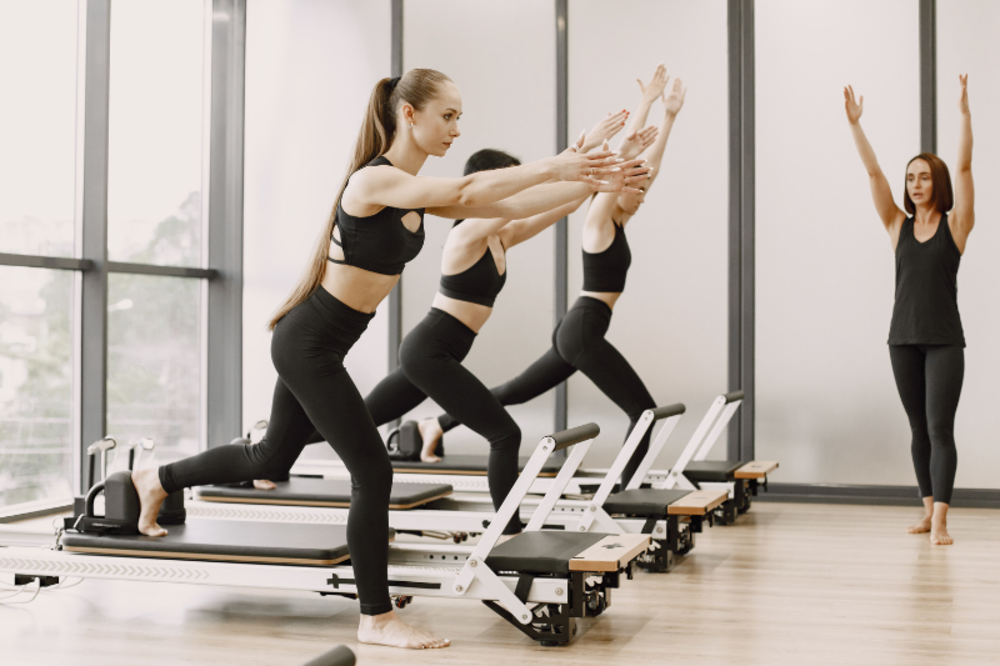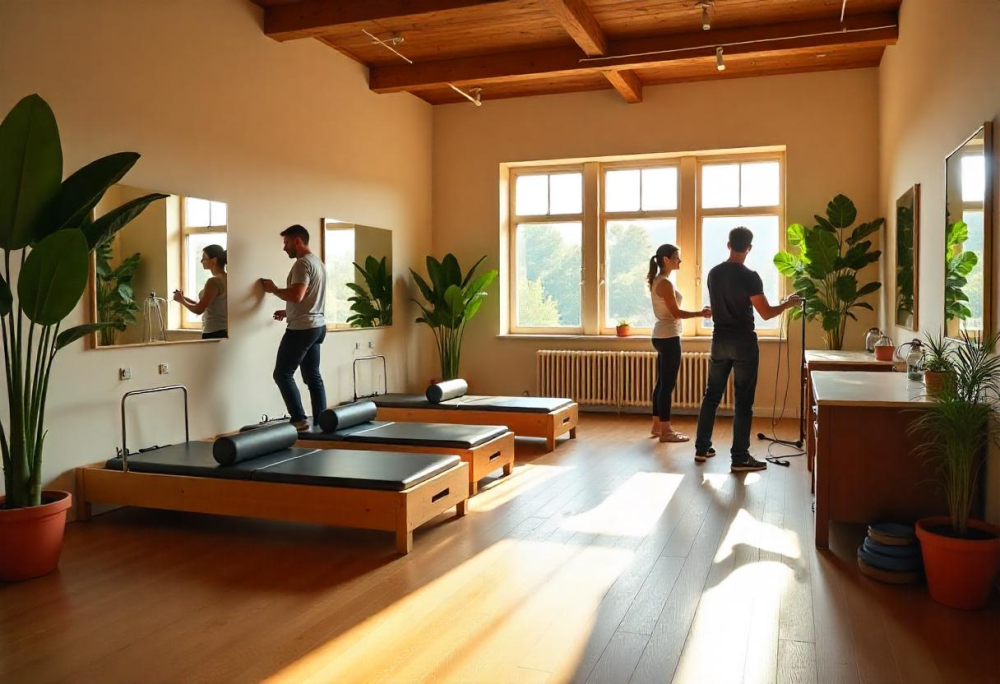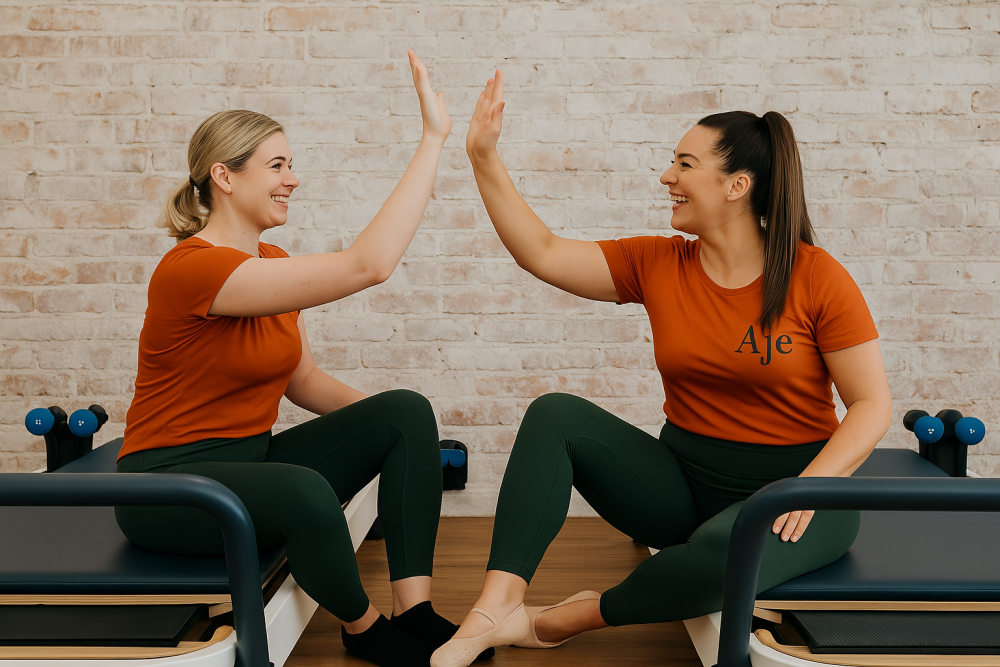You’re here because you’re finally ready to leap.
Maybe you’ve spent years teaching Pilates, building loyal clients, and mastering your craft.
Or maybe you’re newer on the scene but know deep down you’ve got the passion (and drive) to make your own studio a massive success.
Either way, opening your Pilates studio is thrilling and a little nerve-wracking. You’re probably swimming in questions right now:
- Where do I even start?
- What Pilates equipment do I absolutely need (and what can wait)?
- How much money will it actually take to open my doors?
- What about marketing? Insurance? Finding the perfect location?
Take a deep breath. You’re exactly where you need to be.
In this guide, I’m going to walk you step-by-step through everything you need to know about opening a Pilates studio, from initial planning and budgeting to choosing your equipment and attracting your first clients. Let’s begin.
Pilates by the Numbers: A Deep Dive into the Market and Its Growth

Pilates has firmly established itself as one of the leading mind-body fitness methods at this moment.
In the U.S. alone, more than 10 million Americans now practice Pilates regularly, and that number continues to grow each year.
In fact, between 2021 and 2022, Pilates saw a 5.8% growth in participation—one of the most significant increases among all fitness activities (source: Sports & Fitness Industry Association).
It’s no surprise Pilates remains especially popular with women—approximately 84% to 88% of participants are female.
However, male participation is on the rise as more men discover the strength, flexibility, and injury-prevention benefits of this low-impact training style.
From a business perspective, the numbers speak for themselves.
The U.S. Pilates and yoga studio industry is now worth $12 to $15 billion annually, with over 42,000 studios nationwide—a number that grew by 2–3% between 2022 and 2023. The sector also provides over 83,000 jobs.
In the UK, the market is smaller but equally significant. The combined Pilates and yoga studio industry is valued at £1.0 billion (2024), with more than 5,200 studios currently operating and growing steadily.
Pilates Popularity Online: From Google Searches to Social Media Takeover
But it’s not just brick-and-mortar success that shows Pilates’ rise—online interest is booming too.
According to Google Trends, search volume for “Pilates” remains consistently high, with clear spikes during viral moments.
Below is a screenshot of a Google Trends graph showing search interest relative to the highest point in the chart for the U.S. for “Pilates”.

One standout example is the “Wall Pilates” trend, which became the top rising fitness search of 2023/2024, thanks to viral TikTok content and user-led challenges as you can see in the graph below.

Speaking of social media—Pilates is absolutely thriving. On Instagram, the hashtag #Pilates went from 23 million posts in 2022 to over 27 million in mid-2024.
Meanwhile, on TikTok, the trend exploded, with videos under #Pilates amassing over 5.7 billion views by April 2023.
Add to that the influencer effect: certified Pilates instructors, YouTubers like Cassey Ho (Blogilates), and even Hollywood celebrities have helped skyrocket the trend’s visibility.
Their content—often featuring Reformer sessions, morning flows, or posture tips—routinely racks up tens of thousands of likes and shares.
It’s this online community, expert content, and aspirational lifestyle that has positioned Pilates as a must-try fitness method among millennials and Gen Z.
How to Open a Pilates Studio and Become a Pilates Studio Owner?
Enough stats—let’s get practical. Below, we’ll walk you through all the steps you need to take to successfully open your own Pilates studio!
1. Define Your Vision

Think of defining your vision as setting up the perfect class flow; it’s the foundation on which everything else is built.
It’ll influence your equipment choices, your space, your marketing, and even the type of clients who walk through your door.
Choose Your Niche: Reformer, Mat, Hybrid, or Specialty
Ask yourself first: What excites you the most?
- Reformer Studio:
If you love the flow, precision, and challenge the reformer brings (plus the premium prices you can charge), go all in here. Remember, equipment investment is higher, but the payoff can be, too. - Mat Pilates:
Mat Pilates offers flexibility and affordability. You’ll need less equipment and can fit more clients into classes, and it’s ideal if you’re just starting out or want to keep overhead costs lower. - Hybrid Studio:
Blending reformer and mat classes can be an awesome sweet spot. It gives your clients variety and can help attract a broader audience. It’s also great for scaling as clients progress from beginner mat classes to advanced reformer sessions. - Specialty Focus (Prenatal, Rehab, Athletic Performance):
If you’re passionate about working with a specific population, like prenatal moms, athletes, or clients rehabbing injuries, then own that space completely. Specializing positions you as an expert, which makes marketing easier and lets you charge premium rates.
Decide Between a Boutique Studio or a Larger Wellness Space
Now it’s time to pick your vibe:
- Boutique Studio:
Think intimate, personal, and premium. Boutique studios thrive on smaller classes, individual attention, community feel, and higher rates per session. If you love building close-knit communities, a boutique setup is calling your name. - Larger Wellness Space:
This is ideal if you envision adding services like yoga, physical therapy, massage, or nutrition coaching alongside Pilates. A wellness-focused space lets you scale, partner with other professionals, and offer comprehensive services. But it also requires more upfront investment and management energy.
Clarify Your Brand Values and Mission ✨
Your brand values and mission aren’t just marketing buzzwords; they shape every decision you’ll make, big and small.
Ask yourself questions like:
- What type of atmosphere do I want to create? (Warm and welcoming? Sleek and premium? Fun and energetic?)
- What do I want my clients to feel when they walk in and out of my studio?
- What’s my deeper reason for opening my own Pilates studio? (Beyond making money, I mean, money’s good, but passion matters more here.)
Clearly defined values and mission statements attract clients who align with you, making your business stronger from the ground up.
2. Research Your Market

Knowing exactly who your clients are—and what they’re searching for—helps you avoid costly mistakes later on.
Understand Your Local Competition and Audience
It’s time to put on your detective hat. You want to know:
- Who are the existing Pilates studios near you?
Visit their websites, follow their socials, and even book classes. What do they do well? Where could you outshine them? - Who exactly is your ideal target audience?
Are busy professionals squeezing in sessions before work? Moms looking for a community? Athletes or rehab-focused clients needing specialized care?
Getting clear on who you want to serve is the secret sauce behind a successful Pilates studio.
Identify Gaps in Services (e.g., Early Morning Classes, Rehab-Focused Sessions)
You’re looking for unmet needs that your competitors aren’t addressing.
- Maybe no one offers early-morning classes for professionals who need to fit in a session before the commute.
- Perhaps no studio specializes in postpartum Pilates, despite a strong local population of new moms.
- Or maybe classes at local studios are too crowded, leaving room for a premium small-group experience.
When you find these gaps, you’ll know exactly where your studio can stand out.
Use Google Trends and Local SEO Tools to Validate Demand
Don’t just guess—use data.
Google Trends lets you explore whether searches for terms like “Pilates near me”, “reformer Pilates”, or even “Wall Pilates” are growing in your city or region. This gives you real insight into local demand.
Combine that with local SEO research—tools like UberSuggest, AnswerThePublic, or SEMrush—to see what people are Googling in your area.
Fitness directories, Yelp reviews, and Facebook groups are also goldmines for hearing what real clients love (and hate) about current offerings.
Once you know what people want and what’s missing, you’re no longer just opening a Pilates studio—you’re filling a real need.
3. Create a Business Plan

Now, I know, “business plan” sounds like something out of an MBA class, not exactly what you signed up for when you fell in love with Pilates.
But this plan is your roadmap, your safety net, and your ultimate confidence booster as you take the leap.
Let’s break it down step by step.
Executive Summary
In one clear paragraph, sum up exactly what makes your Pilates studio special. This should feel like your “elevator pitch.”
Include your niche (e.g., boutique reformer classes for professionals, prenatal Pilates for new moms), your unique approach, and why your studio will stand out.
For example:
“Flow Pilates is a boutique reformer and mat Pilates studio in downtown San Diego, specializing in intimate classes designed for busy professionals seeking balance, strength, and stress relief. Our mission is to blend high-quality Pilates instruction with personalized attention, helping clients feel stronger, healthier, and more energized from day one.”
Boom. Simple, clear, and instantly attractive to the right people.
Startup Costs and Revenue Projections
How much money you need and how you’ll actually make it back. Consider:
- Startup Costs: Equipment, rent, renovations, Pilates studio software, branding, insurance, certifications, initial marketing budget.
- Revenue Projections: Estimate monthly income based on class pricing, attendance, private sessions, and package sales. Be realistic but optimistic.
Having these numbers on paper (or screen) helps you avoid scary surprises later, and surprises are great for birthdays, not budgets.
Services, Pricing Model, and Packages
What exactly will you offer? Group classes, private sessions, duet sessions, virtual classes, or workshops?
Consider a few pricing models:
- Pay-per-class: Ideal for casual drop-ins or trial sessions.
- Packages (5 or 10 classes): Encourages clients to commit upfront (hello, reliable revenue!).
- Memberships: Monthly recurring income that creates steady cash flow and client loyalty.
Pro tip: Offer attractive “introductory packages” to bring new clients in. For instance, “3 classes for $49” to give newcomers a taste without a big upfront commitment.
Marketing Strategy to Grow your Pilates Studio
Your Pilates studio isn’t a “build-it-and-they-will-come” situation. You need a clear plan to attract and retain your dream clients:
- Social Media: Instagram, TikTok, and YouTube showcase your classes, Pilates instructors, client testimonials, and quick Pilates tips.
- Local Partnerships: Collaborate with nearby coffee shops, gyms, chiropractors, or wellness centers. You share clients, they share clients, and everyone wins.
- Referral Program: Reward your existing clients for bringing friends (free classes, discounted memberships people love freebies!).
- SEO and Local Ads: Use targeted Google and social media ads to boost visibility. Get listed on local directories, fitness sites, and maps.
Legal and Operational Plan
Get your legal and administrative ducks in a row. This isn’t the most glamorous part, but it’ll save you stress later on.
- Business Structure: LLC, Sole Proprietorship, Corporation research what’s best for liability protection and taxes.
- Insurance: Liability insurance (non-negotiable!) and possibly property or workers’ compensation if you hire staff.
- Contracts and Waivers: Clear policies and liability waivers for clients and staff to cover your bases.
- Booking System: Choose intuitive Pilates studio software to schedule classes, track payments, and manage memberships easily.
4. Find the Right Location

Choosing the right location isn’t just about finding a pretty space; it’s about setting yourself up for long-term success.
The right spot attracts clients, keeps them coming back, and becomes a vital part of a thriving Pilates studio’s identity.
Here’s exactly what you need to consider:
What to Look for in a Place
Before you sign anything, put on your inspector’s hat and pay close attention to these details:
- Visibility and Accessibility:
Choose a location that’s easy to spot from the street, ideally in an area with solid foot traffic. Being tucked away can feel cozy, but if new clients struggle to find you, they’ll give up pretty quickly. Street-facing signage or a location near popular businesses can dramatically boost your visibility. - Parking:
Seriously, parking matters a lot. Easy and abundant parking can be the difference between a client attending classes regularly or choosing a competitor. Check if there’s ample street parking, dedicated lot parking, or even nearby garages offering validation options. - Lighting and Ambience:
Natural light can transform the energy of your Pilates space. Look for large windows or skylights that bring in plenty of sunshine, creating an uplifting, welcoming atmosphere. Avoid spaces with overly harsh fluorescent lighting. Trust me, clients notice these details, and it affects their overall experience. - Ventilation and Climate Control:
Good airflow is essential in fitness spaces. Stuffy studios are uncomfortable and a health hazard. Confirm the space has effective HVAC systems, fans, and windows that open. Even better if there’s room for air purifiers, as clients love spaces that prioritize their comfort and well-being. - Noise Levels:
Pilates relies heavily on concentration and relaxation. Ensure your potential space isn’t next door to loud businesses like bars, gyms blasting loud music, or heavily trafficked roads. Peaceful surroundings help clients focus, relax, and keep returning.
Home-based vs. Commercial Studio: Pros and Cons
Let’s unpack this a little more clearly:
Home-based Studio
Pros:
- Lower upfront costs (no separate rent)
- Ultimate convenience: zero commute!
- Easier work-life integration
Cons:
- Limited growth potential due to space constraints
- Less professional perception, which could limit client pricing
- Privacy concerns (clients in your personal space)
Ideal if you want a smaller, intimate client base and reduced overhead.
Commercial Studio
Pros:
- Professional look and feel (clients tend to value this highly)
- Greater visibility and marketing potential
- Easier to scale, host events, or add complementary services
Cons:
- Higher upfront and ongoing costs (rent, utilities, insurance)
- Potential lease obligations (typically 1–5 years minimum)
Great if your vision involves growth, hiring other instructors, or offering additional wellness services.
Zoning Laws and Permits to Consider
This part’s not thrilling, I get it. But zoning laws and permits are critical, and skipping them can lead to expensive headaches later on.
Here’s exactly what you need to check:
- Zoning Regulations:
Confirm with your city planning or zoning office that your desired location is legally approved for fitness-related activities. Some areas have restrictions due to noise, parking, or commercial-use limits. - Permits:
You’ll typically need occupancy permits, signage permits, and potentially health or building permits, depending on your local jurisdiction. Get these applications started early; processing can take weeks or even months. - Building Codes and Accessibility:
Your Pilates studio requires compliance with local building codes, fire safety rules, and accessibility guidelines (like ADA compliance in the U.S.). If you’re renovating, consult a professional early to ensure your studio meets all regulations.
Schedule an in-person appointment or phone call with a local official to review these details thoroughly before signing any lease or purchase agreement.
They’ll appreciate the due diligence, and you’ll avoid frustrating surprises later.
5. Set Up Your Pilates Studio

You’ve nailed down the location and figured out your plan, and now it’s time to make your vision a reality.
Let’s walk through exactly what you need to create a space that clients can’t wait to return to.
Equipment Checklist
Here’s your quick-start shopping list:
- Reformers: Essential for reformer-based Pilates studios. Start small (3-6) and add more as you grow. Look for quality brands like Balanced Body, Merrithew, or Peak Pilates. Your Pilates equipment is your biggest investment, so don’t cut corners here.
- Towers/Cadillac: Great if your studio offers private or semi-private sessions. Towers save space and are versatile; Cadillacs are excellent for rehab and specialty training.
- Mats: High-quality Pilates mats are crucial; even reformer studios should have mats available for stretching, hybrid sessions, or workshops.
- Props: Small props like magic circles, resistance bands, stability balls, foam rollers, and small weights can boost class variety and appeal to clients at different levels.
Design Tips for a Calming, Professional Environment
Your studio’s vibe is everything, clients should feel calm and energized as soon as they step through the door:
- Color Palette: Go for neutral, calming, or earthy tones (think whites, soft blues, grays, or natural wood accents). Clients come to Pilates for peace, clarity, and mindfulness; your decor should reinforce that.
- Layout: Keep it open, airy, and uncluttered. Arrange equipment to allow plenty of personal space and easy flow during classes.
- Comfort Touches: Add plants, cozy waiting area seating, subtle artwork, and fresh towels. Little details elevate your clients’ experience, creating loyalty.
Soundproofing, Mirrors, Lighting, Flooring
These details might seem small, but they matter a lot:
- Soundproofing: Consider adding acoustic panels or thick curtains if your space echoes or is near a noisy street. Pilates relies on concentration, so controlling noise is crucial.
- Mirrors: Full-length mirrors help clients perfect their alignment. Position them strategically, usually along one or two walls, but not everywhere (you don’t want a dance studio vibe).
- Lighting: Aim for warm, adjustable lighting. Natural light is ideal, but soft LED lighting (with dimmers!) can create a cozy, professional feel, especially in the evenings or early mornings.
- Flooring: Choose flooring that’s supportive, durable, and comfortable for both mat and reformer work. Wood-look vinyl flooring or specialized gym flooring are fantastic choices. Avoid carpet; it’s hard to clean and maintain.
Tech Essentials
Let’s talk tech; you’re running a studio in 2025, after all.
- Music System: Invest in quality Bluetooth speakers or a built-in audio system for seamless sound during classes.
- Camera and Streaming Setup: Having a good-quality camera (like Logitech webcams or simple DSLR setups) and stable Wi-Fi ensures you can offer hybrid or virtual classes effortlessly, which is essential in today’s fitness market.
- Pilates Studio Software: The right studio management software can save you hours each week and help you deliver a more professional experience.
6. Handle Legal and Financial Essentials

Okay, I know paperwork isn’t exactly thrilling. But getting your legal and financial basics sorted out upfront saves you headaches down the line.
Let’s breeze through exactly what you need to do so you can confidently get back to what you love: teaching Pilates.
Choose a Business Structure
First up, decide how you’ll structure your business:
- Sole Proprietorship: This is the simplest setup, but it offers no personal liability protection.
- LLC (Limited Liability Company): Protects your personal assets from business liabilities (highly recommended for studios!).
- Corporation (S-Corp or C-Corp): Ideal if you plan significant growth or multiple locations, though it usually involves more complex paperwork and higher taxes.
Most Pilates studio owners choose an LLC because it’s straightforward, flexible, and offers excellent protection.
Register Your Business and Get Licenses
Next, make it official:
- Register your studio’s name with your state or local government.
- Get a federal tax ID (EIN) from the IRS (in the U.S.).
- Obtain local business licenses and permits required for fitness businesses in your city or county.
Do this early; it can take a few weeks to get everything processed.
Liability Insurance and Waivers
Pilates is low-impact, but you still need proper protection:
- Liability Insurance: Essential coverage protects you from injury claims. Expect annual premiums between $500 and $1,500, depending on location and coverage levels.
- Waivers: Have clients sign liability waivers before their first class. Online platforms typically offer easy-to-use digital waivers that integrate smoothly into your onboarding process.
Don’t skip this it’s peace of mind and a professional must-have.
Set Up Business Bank Accounts and Accounting System
Keep your finances tidy from the start:
- Business Bank Account: Separate your personal and business funds clearly. Trust me, your accountant will love you for it.
- Accounting Software: QuickBooks, Xero, or FreshBooks help you track income, expenses, taxes, and invoices easily. Setting this up early avoids stressful tax season scrambles later.
Consider hiring a bookkeeper or accountant, even part-time, if numbers aren’t your strength; it’ll save you endless stress.
7. Choose the Right Pilates Studio Software

You might think software isn’t the most glamorous part of opening your Pilates studio, but trust me, the right software is your best friend.
It streamlines your daily tasks, keeps your clients happy, and frees you up to do what you love most: teaching.
Here’s exactly what you should look for (and what you’ll need):
Booking and Payment Platforms
Look for software that makes booking effortless—for you and your clients.
The best systems, like Virtuagym’s Scheduling Software, allow clients to book and pay seamlessly from their phone or computer.
Bonus points if it lets them manage their memberships, class packages, and cancellations without you lifting a finger.
Client Communication Tools
Clear communication = happy clients. Choose software that offers automated reminders via text or email.
Ideally, you’ll want easy-to-use messaging features so you can quickly send class updates, studio announcements, or special offers to clients.
This makes your life infinitely easier and keeps your clients feeling connected.
Class Scheduling and Attendance Tracking
Gone are the days of pen-and-paper scheduling (thank goodness). Opt for software with intuitive calendars and attendance tracking.
The easier it is to manage classes, track attendance, and handle no-shows or late cancellations, the better your studio will run, and the more time you’ll have for the fun stuff.
Reporting Tools for Studio Performance
This is the gold mine right here.
You want software that offers clear insights into your studio’s financial health, class attendance, revenue projections, and client retention.
Real-time data lets you quickly see what’s working, what’s not, and where you can grow. No guesswork is required.
8. Build a Signature Client Experience

You’re not just teaching Pilates; you’re building relationships, community, and lasting loyalty.
Here’s how to make sure every client feels valued and keeps coming back for more.
Design Onboarding for First-Timers
First impressions matter, big-time. Make your onboarding simple, welcoming, and personal.
Consider sending new clients a welcome email or video with what to expect, what to wear, class etiquette, and studio FAQs.
You’ll get bonus points if you personally greet them at their first class, give them a quick tour, and introduce them to regulars. A confident, comfortable client is a loyal client.
Create Unique Class Programming and Progress Tracking
Clients love seeing their progress. Whether you use simple tracking charts, digital tools, or regular one-on-one check-ins, make sure your clients clearly see their improvements.
Design class programs with clear progression pathways from beginner basics to advanced challenges.
Unique themes (like posture-focused classes, flexibility series, or targeted Pilates exercises for core strength) keep classes fresh and clients hooked.
Offer Small Group and Private Sessions
Personal attention is your secret sauce. Small group or private sessions allow you to give specialized feedback, build deeper relationships, and charge premium prices.
These sessions can also attract clients looking for more individualized attention or those seeking qualified Pilates instructors for rehab, prenatal, or sports-specific training.
Incorporate Workshops or Wellness Add-ons
Want your Pilates studio to truly stand out?
Go beyond typical classes by offering special workshops, retreats, or wellness events. Examples could include:
- Weekend posture workshops
- Pilates and mindfulness events
- Nutrition seminars
- Guest instructor series
These events deepen community bonds, showcase your expertise, and help clients feel truly cared for beyond their weekly class schedule.
9. Market Your Pilates Studio

Your Pilates studio could be incredible, but if no one knows about it, well…you see the problem.
Here’s exactly how you attract your dream clients, build buzz, and fill your classes from day one.
Pre-launch Buzz: Free Trials, Founding Member Offers
Start marketing before your doors open. Offer to entice “founding member” specials, discounted class packs, unlimited monthly memberships at special pricing, or free trials.
This creates urgency, fills your classes fast, and builds momentum from the start.
Pro tip: Host a launch event or open house for your community to let them see your beautiful studio, experience quick demo classes, and meet you personally.
Social Media Strategy
Social media is non-negotiable, especially for Pilates studios:
- Instagram Reels:
Instagram is your visual storefront. Post quick Pilates tips, mini-workouts, client transformations, and behind-the-scenes glimpses of your studio. Reels are great for engagement and reach. - TikTok:
TikTok is perfect for showcasing your studio’s personality. Share fun, energetic clips, creative challenges, or trending Pilates moves. The casual vibe resonates well here. - Local Groups on Facebook:
Facebook still plays a huge role in community building. Join community pages, neighborhood groups, and wellness groups to share your launch events, free classes, or special offers. This creates a strong local buzz.
Partner with Local Businesses
Collaboration = growth. Team up with local wellness brands, coffee shops, chiropractors, therapists, or gyms.
Offer joint promotions, host combined workshops, or simply cross-promote on social media. Everyone wins, especially your clients.
Google Business Profile and Local SEO
People searching “Pilates near me” on Google should find you easily. Here’s how you do it:
- Google Business Profile:
Fully optimize your listing, add photos, class schedules, and offers, and respond actively to reviews. This instantly boosts your local credibility. - Local SEO:
Include location-specific keywords on your website (like “Pilates classes in Austin”) to show up higher in local searches. Update your site regularly with blogs, client stories, or Pilates tips to improve your ranking.
Conclusion

And there we have it, you’re now fully prepared to confidently open and run a Pilates studio that’s uniquely yours.
Remember, as you step into this exciting next chapter, success doesn’t come from doing everything perfectly right away; it comes from continually adapting, learning, and staying deeply connected to your passion and your clients.
Stay true to your vision, trust yourself, and most importantly, enjoy the journey. You’re about to create something truly special.



